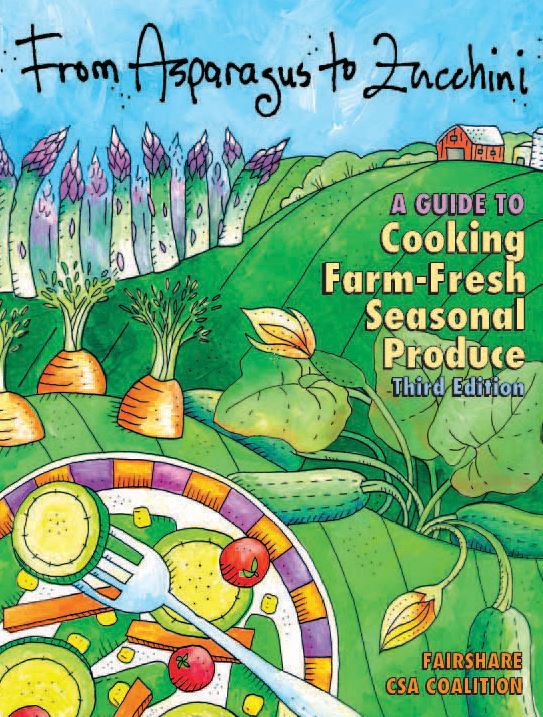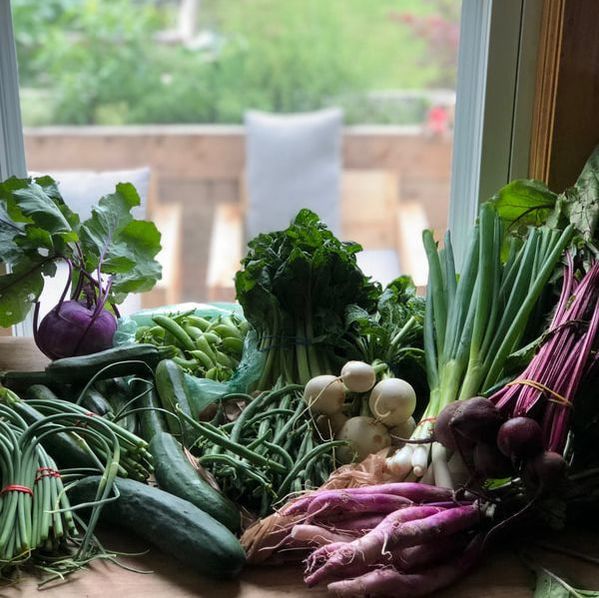In my early twenties, I was working for a gardener who took me to her CSA* farm for a volunteer shift. Instead of toiling in urban backyards, we got our hands dirty in rural Wisconsin for the day. I can't pretend to remember what we farm chores we did, but the experience had an deep impact on me. I became a member of that same farm the following season and have been one every since.
I had been introduced to local foods while working at the Birchwood Cafe. Farmers delivered fresh veggies, meat, milk, cheese and eggs for seasonal menu items at the restaurant, stopping by the counter for a coffee on their way back to their farms. I got to chit chat with them there, learning about their farms and philosophies. This sneak peek at the farm-to-fork experience changed how I thought about food. Honestly, it was a catalyst for repairing my relationship with food. After raging my internal food fight for more than a decade, I welcomed the paradigm shift with open arms.
Slowly, the role of food in my life became more than calories or nutrition. It became the invitation to relationships and community. I changed my buying habits, shifting my priorities in the grocery store from cheap to local. The investment was worth it to me - I knew that with every dollar I spent I was supporting people. I fed my body well with locally grown, seasonal produce, pasture-raised meats and eggs, and in so doing also financially invested in small, family farms in my community. I sat down to meals knowing where every ingredient came from.
I fell in love with food with a face.
I couldn't have made the transition from a I-can-have-anything-I-want-whenever-I-want-it diet to one based on local foods without From Asparagus to Zucchini. When I got my first CSA box, I didn't know what half of the contents were...much less how to store or prepare them! My dog-eared copy of From A to Z got me through the learning curve, and is still a cookbook I reference today.
This cookbook is a guide to seasonal produce, grown in the Midwest. Organized by vegetable in alphabetical order, the authors give tips for choosing the best product at the farmers market, storing for lasting quality, and several recipes centered around the ingredient.
Here's another reason why I love From A to Z: every recipe comes from a farm or CSA member, NOT a chef. That means that each recipe is totally doable to cooks of all skill levels.
If you signed up for a CSA for the first time, you need this cookbook.**
If you're committed to shopping farmers markets, you need this cookbook.
If you're trying to eat more vegetables, you need this cookbook.
If you're committed to supporting small, family farms like I am, you need this cookbook.
Buy this cookbook!**
I had been introduced to local foods while working at the Birchwood Cafe. Farmers delivered fresh veggies, meat, milk, cheese and eggs for seasonal menu items at the restaurant, stopping by the counter for a coffee on their way back to their farms. I got to chit chat with them there, learning about their farms and philosophies. This sneak peek at the farm-to-fork experience changed how I thought about food. Honestly, it was a catalyst for repairing my relationship with food. After raging my internal food fight for more than a decade, I welcomed the paradigm shift with open arms.
Slowly, the role of food in my life became more than calories or nutrition. It became the invitation to relationships and community. I changed my buying habits, shifting my priorities in the grocery store from cheap to local. The investment was worth it to me - I knew that with every dollar I spent I was supporting people. I fed my body well with locally grown, seasonal produce, pasture-raised meats and eggs, and in so doing also financially invested in small, family farms in my community. I sat down to meals knowing where every ingredient came from.
I fell in love with food with a face.
I couldn't have made the transition from a I-can-have-anything-I-want-whenever-I-want-it diet to one based on local foods without From Asparagus to Zucchini. When I got my first CSA box, I didn't know what half of the contents were...much less how to store or prepare them! My dog-eared copy of From A to Z got me through the learning curve, and is still a cookbook I reference today.
This cookbook is a guide to seasonal produce, grown in the Midwest. Organized by vegetable in alphabetical order, the authors give tips for choosing the best product at the farmers market, storing for lasting quality, and several recipes centered around the ingredient.
Here's another reason why I love From A to Z: every recipe comes from a farm or CSA member, NOT a chef. That means that each recipe is totally doable to cooks of all skill levels.
If you signed up for a CSA for the first time, you need this cookbook.**
If you're committed to shopping farmers markets, you need this cookbook.
If you're trying to eat more vegetables, you need this cookbook.
If you're committed to supporting small, family farms like I am, you need this cookbook.
Buy this cookbook!**
*Community supported agriculture (CSA) is a business model that allows consumers ("members") to invest in a growing season of a farm. Members share the risk of farming with the farmer. This helps to ensure that they have the income they need to make the business sustainable for them. In exchange for the investment, farmers distribute "shares" of their product. There are all kinds of CSAs now: vegetables, meat, cheese, even pie and art! The most common CSA good is vegetables. Members receive weekly allotments of the produce grown on the farm throughout the growing season. It's a win-win!
**Another way to support small, family businesses is to buy books from your local bookstore, instead of Amazon. My Minneapolis favorites are Magers and Quinn and Moon Palace. Both stores have their inventory online making it easy to see if they have what you're looking for before making the trip. You can even order books online to have shipped to you, just like Amazon.

